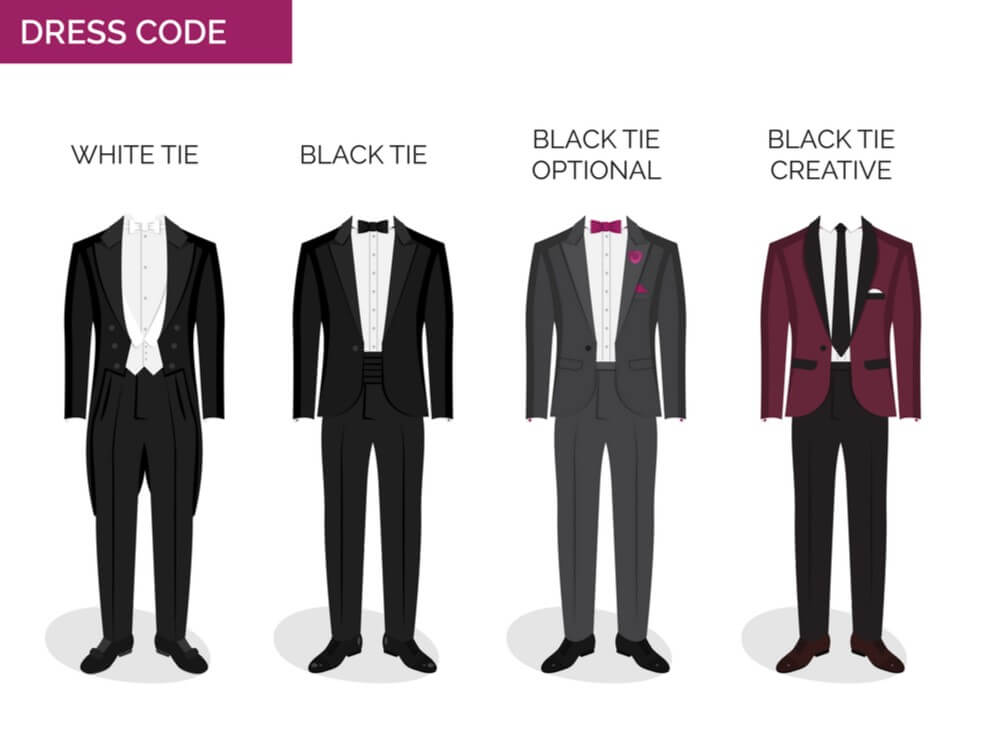Just been invited to a big event but can’t figure out what the dress code means? Don’t worry, decoding event attire isn’t as tough as it might seem. All you really need to understand are the seven most common guys’ dress codes you’ll hear mentioned for both events and professional settings. The only time this can get tricky is when an event invite is sent without mentioning a specific dress code.
Don’t feel weird about asking the host what kind of attire is expected. He or she will probably appreciate that you care enough to ask. You can usually figure out what level of dress is appropriate from the venue and type of event. Fancier parties like galas and silent auctions are usually semi-formal while laid-back get togethers like backyard barbecues are obviously pretty casual, so please don’t show up in a tux.
The Top Seven Men’s Dress Codes
White Tie
We’ll start with the most formal dress code you’ll see–white tie. This is saved for only the classiest of the classy events. Like Met Gala-level classy. As in, most people probably won’t ever even attend a white tie event. But, it’s still good to know, just in case you end up rubbing shoulders with some high-profile celebrities or get nominated for a Nobel Peace Prize. You know, normal everyday stuff. Should you someday be invited to a white tie event, you’ll probably need to rent the proper clothing since most people don’t have suits with tailcoats just lying around in their closets. For men, white tie means ultimate formal wear—a white shirt, black dress pants, an evening jacket with tailcoats and a white bow tie.
Black Tie

It’s pretty rare to see a white tie dress code. If you’re going to a fancy event, it’s much more likely to have a black tie requirement–or even black tie optional. (Don’t worry, we’ll explain the difference.) For a black tie event, you can ditch the tailcoat jacket for a regular tuxedo. And skip the white bow tie. A regular, black bow tie is standard for this dress code.
Black Tie Optional
Do not make the mistake of thinking that black tie and black tie optional are the same dress code. They absolutely are not. And the difference is crucial. If you’re attending a black tie event, you are required to wear a tux. Otherwise, you’re going to be the most underdressed person at the party. At a black tie optional event, the tie is—you guessed it—optional. Basically, you should still be wearing a suit but a tuxedo is not required. If you don’t own one, or you just don’t want to wear one, a dark-colored suit is perfectly acceptable. For those who skip the full tux, definitely add a tie to your suit for a slightly more formal appearance.
Business
Business dress is where things can become a little tricky. With white tie, black tie and black tie optional, men’s clothing options are pretty straightforward. Business dress is usually only required at an office or during work-related events or meetings. This code is slightly more formal than business casual, so it has a few more rules. Think: every guy on Mad Men when trying to nail down the business dress code. A matching suit is a must. Add a professional button-down shirt underneath, throw on a tie and finish the outfit with a pair of nice leather dress shoes.
Business Casual

Depending on where you work, business casual can mean different things. Sometimes, it means you should still wear a suit but ditch the tie and have more options with footwear. But, most of the time it means no suit. Instead, throw on a nice sport shirt under a blazer or jacket, paired with chino pants. Ties are definitely not necessary if you’re trying to follow a business casual code. If you’re not sure whether your office is okay with skipping the suit, take a look at other employees’ outfits or just flat-out ask your supervisor. It’s better to be honest and straightforward than show up looking out of place.
Smart Casual
This one usually leaves a lot of people scratching their heads. Casual, okay, we get that. But smart? The smart casual dress code is pretty new to the world of men’s fashion, sometimes called startup company chic. You know the look–dark jeans with a sports shirt under a blazer made from a funky material like corduroy. We dig it. But this dress code might be too casual for some professional settings, so be sure to clarify before showing up on your first day in a blue velvet blazer.
Casual
You know how to dress casually. You probably use this as your daily dress code. To be clear, casual doesn’t mean gym shorts. That’s more like ultra casual. If an invitation tells you that the dress code is casual, you can relax. For an outdoor cookout in the summer, you can pair chino shorts with a sports shirt to stay comfortable. When it’s a little chillier, chinos are the perfect casual pants that go perfectly with a polo shirt.
Formal vs. Semi-Formal
Before we let you go try out these dress codes for yourself, we want to clarify one thing. Black tie attire is not considered formal wear. White tie dress is the only code that falls under formal wear. A lot of people use the term “formal dress” incorrectly, mistaking it for the still-fancy-but-not-quite-fancy-enough semi-formal attire. Black tie and black tie optional are both considered semi-formal. You should try to keep this in mind when you get invited somewhere.
Now that you know the rules of the most popular men’s dress codes, we’re expecting you to be the best dressed guest at your next party. And if you ever forget the difference between black tie and black tie optional, just check this guide for a little refresher. We got your back.
